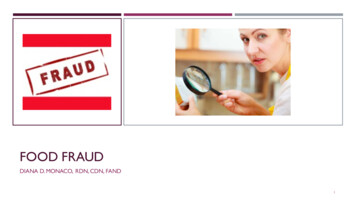
Transcription
FOOD FRAUDDIANA D. MONACO, RDN, CDN, FAND1
DEFINITION OF FOOD FRAUD¡ Food fraud is the act of purposely altering, misrepresenting,mislabeling, substituting or tampering with any food product atany point along the farm–to–table food supply–chain.¡ Fraud can occur in the raw material, in an ingredient, in thefinal product or in the food’s packaging.¡ Fraudulent and intentional substitution, dilution oraddition to a raw material or food product, ormisrepresentation of the material or product forfinancial gain (by increasing its apparent value or reducing itscost of production) or to cause harm to others (by maliciouscontamination), is ‘food fraud.’2
REVIEW OF FOOD INGREDIENTS,ADULTERANT-SUBSTANCES,ANDESTIMATED ECONOMIC GAIN, PER UNIT PER FRAUD INCIDENTFood ingredientAdulterant-substanceEconomic gainUnitsWheat GlutenMelamine 31,000Truckload (50 k lbs.)WheatUrea 11,000Bin (10 k bushels)Apple JuiceHigh Fructose Corn syrup or Hydrolyzed Chicory syrupTomatoesSpices (e.g., Paprika, Curry, Chili Powder,etc.) 18,000Truckload (50 k lbs.)Maltodextrin 12,000Truckload (50 k lbs.)Sudan DyesUndefined Note: 0.06 of dye probably increasesprofit by 1þ/3
FOOD FRAUD ON THE RISE¡ Food fraud is estimated to cost the global food industry 10- 15 billiona year.¡ According to the U.S. Congressional Research Service, there have been60 percent as many incidents of food adulteration from 2011 to 2012than had been identified in the 30 years between 1980 and 2010.¡ Food fraud is nothing new, but the intensity and frequency have been onthe rise.¡ Globalization and a much more complex supply chain are contributors.¡ It is also very difficult for consumers to judge the characteristics of theproduct.4
FOOD FRAUD – WORLDWIDE PROBLEMFood fraud is the deception of consumersthrough intentional adulteration of food:(a) by substituting one product for another;(b) using unapproved enhancements or additives;(c) misrepresenting something (e.g., country of origin);(d) misbranding or counterfeiting;(mislabeling);(e) stolen food shipments (Grey market Theft/Diversion) and/or(f) intentional contamination with a variety ofchemicals, biological agents or other substancesharmful to private– or public–health5
WAYS TO DECEIVE¡ ADULTERATION ( ingredient substitution, dilution,and concealment, or impurities)¡ ARTIFICIAL ENHANCEMENT¡ USE OF UNDECLARED, UNAPPROVED, orBANNED BIOCIDES¡ REMOVAL OF AUTHENTIC CONSTITUENTS¡ MISREPRESENTATION OF NUTRITIONAL VALUE¡ FRAUDULENT LABELING CLAIMS¡ FORMULATION OF A FRAUDULENT PRODUCT¡ TAMPERING (date code, refilling containers)¡ THEFT (e.g. employees theft, shoplifting and cargotheft)¡ DIVERSION (e.g. grey markets and parallel trade)¡ COUNTERFEITS (e.g. Intellectual property rightsinfringement)¡ OVERUNS6
U.S. PHARMACOPEIAL (USP) CONVENTION'S FOOD FRAUD DATABASE.August 2, 2016¡ Food Fraud Database (FFD 2.0)¡ a continuously updated collection of thousands ofingredients and related records gathered fromscientific literature, media publications, regulatoryreports, judicial records, and trade associations fromaround the world.¡ FFD v2.0 is available through an annual subscription.¡ www.foodfraud.orgFood fraud, also referred to aseconomically-motivated adulteration(EMA), is a global economic and public healthproblem, costing industry an estimated 10 to 15billion dollars annually and affecting as much as 10% of theglobal food supply.7
OCEANA8
EXAMPLES OF FOOD FRAUD¡November 2015 to February 2016:¡In the UK, about 10,000 liters of fake or adulterated wine, whiskey, and vodka. InGreece, more than 7,400 bottles of fake alcohol and counterfeit labels. The seizedalcohol was enough to fill 12,000 bathtubs. In Australia, nearly 1,000 pounds of adulterated or blended honey, plus peanutsrepackaged as more expensive pine nuts (a major risk for people with allergies). In a warehouse in Bolivia, thousands of cans of sardines with fake labels of afamous Peruvian brand ready to be put on them. In Italy, more than 85 tons of olives that had been dipped in copper sulphatesolution to boost color. In Hungary, more than 2 tons of duck meat being passed off as duck liver (that is,pricey foie gras). In Thailand, more than 30 tons of illegal beef and buffalo meat that was not fit forhuman consumption, but was on its way to supermarkets.9
WHAT ARE THE TOP TWO ADULTERATED FOODS?10
THE TOP TEN MOST ADULTERATED FOODS IN THE UNITED STATESThe Top Ten most adulterated foods in the United States in2013 were:(1) olive oil,(2) milk,(3) honey,(4) saffron,(5) orange juice,(6) coffee,(7) apple juice,(8) grape wine,(9 tie) vanilla extract, (9 tie) maple syrup.11
OLIVE OILOlive oil is the food most subject to fraud, accordingto the Journal of Food Sciences study. – 16%They defraud consumers in three main ways:(1) by diluting real extra-virgin olive oil with lessexpensive oils, like soybean, hazelnut or sunflower oil;(2) by diluting high-quality olive oil with low-qualityolive oil; or(3) by making low-quality extra-virgin olive oil, typicallyincorporating older—and often rancid—stocks of oilheld over from bumper crops of previous seasons12
THREE OIL CASES¡In Spain in 1981 people died after "olive oil" that was actually a nonfood-grade (industrial-grade) rapeseed oil intended as an industriallubricant was sold. There were 20,000 people sick and it killed 1,200.¡ In 1998, adulteration of cooking oils in India made with oil from theMexican Poppy (Argemone mexicana) made more than 2,500 people sickand killed at least 65.¡ 2016- the Italian press revealed large-scale olive oil fraud. Products fromseven major olive oil producers labelled as Extra Virgin Olive Oil alsocontained significant amounts of lower quality oils and therefore did notmeet EU labelling rules for extra virgin olive oil.13
INTERNATIONAL OLIVE OIL BUYING TIPSInternational olive oils, look for the Protected Designation of Origin logo, whichguarantees that these oils were indeed produced, processed, and prepared in a specificregion of the labeled country using traditional production methods—as opposed tocontaining oils from elsewhere (often soybean or hazelnut oil) that were simply bottled inthe labeled country.¡French olive oils will sport an “AOC” (Appelation d’origine contrôlée) logo.¡Italian olive oil will show a “DOP” (Denominazione di Origine Protetta)logo, and¡Spanish olive oil will have a “DO” (Denominación de Origen) seal.¡Look for Extra Virgin Alliance (EVA) and UNAPROL, the respected Italian olivegrowers’ association.14
DOMESTIC OLIVE OIL BUYING TIPS¡ Look for the California Olive Oil Council(COOC) logo on a bottle, or order directly fromits certified producers. In order to earn theCOOC’s “certified extra virgin” seal, olive oilproducers must submit a laboratory analysis and havesamples evaluated by the COOC Taste Panel.¡ Look for the label “USDA Quality Monitored.”15
COUNTRY OF ORIGIN AND OLIVE OIL¡ Current international standards for extra virgin oliveoil allow a wide range of oil qualities to be marketedas extra virgin. In addition, the standards are widelyunenforced.Judge the country of origin:¡ Chile or Australia.: The two countries received thehighest marks from the US International TradeCommission’s report on average quality of extravirgin olive oil.16
BALSAMIC VINEGAR¡Top of the line balsamic vinegar, officially known as Aceto Balsamico Tradizionale, stemsfrom grape varieties grown in one of two provinces in northern Italy—Reggio Emiliaand Modena.¡Most of the supermarket brands are mass produced with caramel, sugarand other flavorings and preservatives. True traditional balsamic vinegarhas only one ingredient: cooked grape must, or mosto d’uva cotto. It is thegrape juice that contains stems, seeds, and skins—is cooked over low heatuntil it is quite thick and dark brown, then left to rest, activating the naturalfermentation¡The vinegar is poured into smaller and smaller barrels as it ages, anywhere from 12 to50 years. Each barrel is made of specific woods that help give balsamic vinegar itsunique, multilayered taste.¡Imitation balsamic vinegar starts off with wine, rather than grape must, and usually hassweeteners and coloring added during its quick processing to give it the appearanceand flavor of aged balsamic.17
SPOTTING HIGH QUALITY BALSAMIC VINEGAREXTRAVECCHIO ACETO BALSAMICOTRADIZIONALE DI MODENA DOP GOLDSEAL BALSAMIC VINEGAR 195.95SKU AFF-002¡A high price does not guarantee authenticity, but you will never come acrossauthentic Aceto Balsamico Tradizionale at a bargain price. (It may instead be theless expensive Aceto Balsamico di Modena.)¡The DOP seal on balsamic vinegar from Italy guarantees that the bottlewas produced and bottled in Italy using traditional methods and following strictlyregulated guidelines set forth by the Italian government.¡To spot the legitimate balsamic vinegar varieties, you want to see theword “tradizionale” on the label, and “grape must” or “aged grapemust” should be listed as an ingredient.¡On the back label it should also say produced and bottled by. Thismeans the producer actually grew the grapes used in the vinegar and producedthe vinegar too. It’s an indication of higher quality.¡There will be a seal on top of the bottle. This seal bears a number and ahologram, a sign of certification from the Consorzio.18
SPOTTING HIGH QUALITY BALSAMIC VINEGAR¡Extra vecchio means the vinegar has been aged at least 25years.¡Affinato means the vinegar has been aged at least 12 years.¡What is Aceto Balsamico di Modena I.G.P.? The initialsI.G.P. stand for protected geographical indication.¡I.G.P. balsamic vinegar can be high quality when made the sameway as traditional balsamic vinegar. It is aged for less time, aminimum of six years, vs. a minimum of 12 years for traditionalbalsamic. Caramel, means it has been added for color and is ofa lesser quality.¡I.G.P. balsamic vinegars are less expensive since they aren’t agedas long. Expect to pay in the 25- 50 range for a good bottle.¡What is a balsamic vinegar condimento? You will also seebalsamic vinegar “condiment.” Depending on the producer, thiscan also be a high quality product and a good alternative totraditional balsamic vinegar for every day use.¡Condimentos make great salad dressings.They are much lessexpensive too, although a good one can cost more than 30.19
PARMIGIANO-REGGIANO¡ Wood Pulp or Potato Starch - These additives areused to prevent clumping.¡ Wood pulp is actually considered safe forconsumption in certain quantities.¡ There may be a temptation to use more thannecessary. Wood pulp is cheaper than cheese, sosome companies may use more to undercut theircompetition.¡ Authentic Parmesan cheese (without the wood pulp),look for the full name “Parmigiano-Reggiano”and make sure it reads, “made in Italy.”20
CUTTING MILK¡ Sheep's milk has been found to be cut with bovinemilk, and buffalo milk with goat-antelope milk.¡ Milk has also been adulterated with reconstitutedmilk powder, urea, and rennet.¡ Milk has even been cut with something called“fake milk”: a mixture of oil, urea, detergent, causticsoda, sugar, salt, and skim milk powder.21
BABY FORMULA¡ Although not a top offender in the Food Fraud database, baby formulaposes considerable food fraud risk.¡ Formula is one of the most common targets for organized retail theftand criminals often tamper with the sell-by codes to move expiredproduct.¡ Adulterated milk, which can make it into formula, also poses a concern.¡ TIPS: Buy from a major retailer rather than less-monitored venues suchas flea markets and online auctions.And don't buy any package that has ablurred-out expiration date or otherwise looks tampered with.22
HONEY AND MAPLE SYRUPHoney and maple syrup may be processed with corn syrup andother sugars to increase their sweetness, and to dilutethem; both products are expensive to produce and process, and alow-cost filler can make them stretch further.¡The Journal of Food Sciences study says honey represents 7% offood fraud cases. Food Safety News tests also found that 75% ofstore honey doesn't contain pollen. People are still buying abee-made product, but all the pollen has been screened out,.¡A lack of pollen makes it tough to determine its geographicorigin -- and also means regulators don't recognize the productas honey.¡Food Safety News tests found a third of the faux honey importsfrom Asia were contaminated with heavy metals like lead andillegal Chinese antibiotics.23
ALLOWRIE BRANDED MIXED BLOSSOM HONEY¡Australia’s biggest listed honey company and some of the country’slargest supermarket chains face accusations of selling fake honey.¡Testing at a leading international scientific lab that specializes in honeyfraud detection has found almost half the samples selected fromsupermarket shelves was “adulterated”, meaning it had been mixedwith other substances. The adulterated samples were all products thatblend local and imported honey.¡Capilano’s Allowrie branded Mixed Blossom Honey, which sourceshoney from Australia and overseas, and markets itself as 100 per centhoney, showed up as “adulterated” in the majority of samples tested.¡Experts say adulterated honey was generally bulked up withrice syrup and beet syrup and other unidentified substances,which aren’t detected by official honey tests.¡International fraudsters, often criminal gangs in China, produce the fakehoney and sell it to unsuspecting suppliers at a higher price, making afortune along the way.¡SEPTEMBER 201824
ADULTRATED SPICESFood fraud in spices:¡ Saffron represents 5%¡ Vanilla extract, 2%.¡ For herbs, a recent study found that 25% of 78 samples¡ Turmeric, star anise, paprika and chili powderof dried oregano bought from UK retailers containedingredients other than oregano.¡ Paprika can be flavorless leftovers of spices that have¡ Borate, glycerin, barium sulfate, and a variety of othereach account for another 1%.already been processed for extracts or even brick dust.chemicals have been found in spice jars.¡ Chinese star anise, may be substituted with toxicJapanese star anise.¡ Consumers should be cautious about buying frommarkets or bulk bins without knowing the spice's origin.25
SAFFRON¡ Saffron, an extremely expensive spice, is a common culprit offood fraud. Many packaged spices contain adulterants, especiallyif they’re sold in powdered form, because the original spice is socostly.¡ According to the Food Fraud Database, saffron can actuallycontain marigold flowers, corn silk, chalk, dyed onions andstrands of cotton or plastic thread, glycerin, sandalwood dust,tartrazine (a yellow dye linked to hyperactivity in children andlupus); barium sulfate (a fluid mainly used in oil well drilling); andborax.¡ The best way to avoid fake saffron is to buy the spice in wholethreads, which is more difficult to fake.26
VANILLA FRAUD¡ Misrepresentation of country of origin¡ and adulterating real vanilla with artificial vanilla.(natural vs. synthetic)¡ dilution¡ The primary flavoring compound used to makeartificial vanilla, vanillin, is a relatively inexpensivebyproduct of the chemical and paper industries.¡ Madagascar vanilla is thought to contain the highestlevels of vanillin. Adding synthetic vanilla to pureMadagascar vanilla- economic fraud, deception¡ Adulteration with synthetic coumarin which has apleasant sweet, fresh scent and is not permitted tobe used as a food additive due to its toxicity can alsooccur.¡ Tonka beans, which contain naturally high levels ofcoumarin have also beenused as vanilla substitutes,including in 'Mexican vanilla'.27
BLACK PEPPER¡Pepper has a history of beingtainted with starch, flour,buckwheat, and millet, chilipowder and paprika fakedwith dyes, sand, twigs andleaves.¡ Whole black peppercornsare also fraudulentlyreplaced with or dilutedwith papaya seeds.28
ABOUT 84.5% OF FOOD SAMPLES COLLECTED ONCHAR DHAM ROUTES ADULTERATEDAN ARTICLE FROM FnBnEWS.com of IndiaOf the 1,186 food samples collected over the last three months by the Society ofPollution and Environmental Conservation Scientists (SPECS), Dehradun,Uttarakhand, from 47 places along the Char Dham Yatra routes of Garhwal region ofUttarakhand, 1,003 samples (or a whopping 84.5 per cent) were found to beadulterated.Eighty-four per cent of the adulteration in foodstuff took place on the BadrinathKedarnath route, while 84.5 per cent adulteration in foodstuff took place on theGangotri-Yamnotri Route.Eighty-one per cent of the iodized salt samples contained no iodine.The prasad (offerings to gods in the temples) is also of a poor quality. Ilaichi danawas found to contain chemicals. The coconut was found to be stale and of a poorquality, as were chhuara, cashew and kishmish in Kedarnath. The pure ghee offeredto Kedarnath Ji was also found to be adulterated.Chilli sauce, tomato sauce and vinegar used for chow mein and otherChinese meals were found to be 100 per cent adulterated.Sindoor, or roli, was found to contain 100 per cent toxic chemicals. It can cause localirritation and skin toxicity. The nature of sindoor, or kumkum, can change withexposure to the environment over time, and this can result in blisters, itching,29rashes, pigmentation and, at times, serious dermatological disorders. AUGUST 2018
WATERING DOWN ORANGE JUICE AND POMEGRANATE JUICE¡Diluted juices, especially expensive ones, sometimes havelittle or no notable change in taste or consistency.¡Orange juice represents 4% of cases in the U.S.Pharmacopeial Convention's Food Fraud Database, andapple juice, 2%.¡Consumers buying one of those common juices might getmore water for their money, while an expensive one likepomegranate may be cut with apple juice.¡Consumers should be especially careful to read labels andpick a trusted brand when buying into the latest super-fruitcraze. It takes time to build up supply of a newly hot fruit, sothose products are more likely to be adulterated.30
ORANGE JUICE¡ Adulterants include illegal fungicide¡ OJ has been shown to host unlisted¡lemon juice,¡mandarin juice,¡grapefruit juice,¡high fructose corn syrup,¡paprika extract,¡and beet sugar31
JUICES AND CLOUDING AGENTS¡Juices may also contain ‘clouding agents’ to make them look fresh,and some of these could make consumers sick.¡The US Pharmacopeial Convention found 877 food products from315 companies with fake clouding agents.¡Most common fraudster :¡The plasticizer Di(2-ethylhexyl) phthalate (DEHP), a chemical that's beenlinked with cancer and thwarted reproductive development in children.DEFINITION:¡Clouding agents or Cloudy Agent/Cloudifier are a type of foodadditive used to make beverages such as fruit juices to look morecloudy, and thus more natural-looking and visually appealing, typicallyby creating an emulsion of oil droplets.32
COFFEE AND TEAFood fraud with ground and instantcoffee along with teas may contain¡twigs, paper, malt, chicory, starchand various grains, roasted corn,ground roasted barley, and evenroasted ground parchment,cereals, caramel, starch, malt, andfigs.¡ Gluten intolerant individuals canget symptoms¡ Suggestion: To avoid theadulterated beans, buy wholebeans and grind them at home.33
TEAResearchers found that tea has been polluted with¡leaves from other plants,¡color additives,¡and even colored saw dust.34
THE U.S. SEAFOOD SUPPLYImported Seafood Supply - Over 90% of theseafood consumed in the U.S. is imported from othercountries around the world.The leading foreign suppliers of seafood products tothe U.S. in 2014 were:Shrimp is the leading fresh or frozen product imported into the U.S.accounting for about 33% of all imports by weight followed byChina,Canada,Thailand,Vietnam,Canned seafood products represent about 12% of all imported seafood,and canned tuna was over half of all canned imports.Indonesia andChileAbout 2% of all imported seafood products were cured.About two thirds of the edible seafoodimported into the U.S. came from these sixcountries.35
FAUX FISH¡ 2012 study by Oceana discovered that almost 40% of¡ Farmed fish also get advertised as more expensive wildfish sold in New York City was mislabeled.¡ A 2013 U.S. study conducted by Oceana found 38 percent of all restaurants sampled and 74 per cent of allsushi eateries, mislabeled the species of fish served.¡ It may be advertised as wild caught when it’s farmed, oras a totally different species.¡ And when fish is sold in fillet or frozen form, it’s hard totell what it is and where it came from without genetictesting.versions.¡Scallops, for example, might actually be punched outcircles from a whitefish fillet,.¡Grouper might be what it is labeled but it is reallytilefish, a species that contains enough mercury to makethe FDA's list of foods that pregnant women and youngchildren should avoid.Experts suggest buying whole fish when possible – whichare harder to fake.36
MANY FISH LOOK ALIKE¡ (From top) Oceana paired wild salmon, red snapperand halibut, all on the left, with other fish that lookremarkably similar to demonstrate how easy itwould be to mislabel them.37
GROUPER, OR IS IT?¡ Diners' knowledge of frequently mislabeled fish wastested with an escabeche-style grouper, left, pairedwith an escabeche-style weakfish, right, andpotatoes between them.38
WILD OR FARM RAISED SALMON?¡ Wild Alaskan king salmon, at left, with farm-raisedsalmon, right, are served at a dinner at the NationalAquarium in Washington, D.C.39
RED SNAPPER OR TILAPIA?¡ Fillets of chimichurri-crusted red snapper and tilapia,separated by fresh corn polenta.40
EXAMPLES OF COMMONLY MISLABELED SEAFOODYOU PURCHASED/YOU RECEIVEDRED SNAPPERYOU PURCHASED /YOU RECEIVEDSlender Pinjalo, ChannelCatfish, Nile Perch,MahiMahi, Mullet Snapper,Malabar Blood Snapper,Atlantic CodBLUEFIN TUNABigeye Tuna,Yellowfin TunaWHITE TUNAEscolarWHITE SNAPPERWhite HakeMAHI MAHIYellowtailATLANTIC CODGROUPERChannel Catfish, Hake,Tilapia,Alaska Pollock, NilePerchAlaska Pollock, NorwegianPollock,Whiting, Saithe,EscolarCHILEAN SEA BASSWhite Bass, Striped BassSHARK MEATNile PerchWILD SALMONFarmed Salmon41
EXAMPLES OF COMMONLY MISLABELED SEAFOODYOU PURCHASED/YOU RECEIVEDYOU PURCHASE/YOU RECEIVEDSWORDFISHMako FishRED MULLETSpotted GoatfishRED DRUMBlack DrumMONKFISHPufferfishHALIBUTSea Bass, Deep WaterCape HakeHADDOCKSaitheANCHOVIESIcefishORANGE ROUGHYOreo Dory, John Dory42
¡ Health authorities in the Japanese city of Gamagori were forced toEMERGENCYALERT IN JAPANAFTERSUPERMARKETACCIDENTALLYSOLD EXTREMELYTOXIC FISHJANUARY 2018activate an emergency warning system after a local supermarketaccidentally sold five packages of potentially deadly pufferfish tocustomers.¡ The fish, called fugu in Japan, is prized as a delicacy, but has also beendubbed the 'Russian roulette' of dining because it contains a dangerouspoison called tetrodotoxin, the consumption of which can be fatal tohumans.¡ In fact, at least 10 Japanese people have died since 2006 from eating thetoxic fish, and it used to be far worse – fugu's death toll peaked in 1958with a stunning 176 victims, when awareness of the dangers was lower.43
WHITE TUNA¡ There have been countless cases of people gettingsick from the bait-and switch of white tuna forcheaper escolar, a bottom-feeder fish that’s full of awaxy substance that is indigestible by humans.¡ It can lead to severe gastrointestinal distress (it’sknown as the “Ex-Lax fish”).¡ Escolar is a type of snake mackerel. Sometimes it'sunder the name "butterfish," "oilfish," or"waloo/walu."¡ Sushi restaurants occasionally serve it as "superwhite tuna" or "king tuna." It's cheap, it'ssustainable, and it's buttery and succulent.44
ESCOLAR WARNINGS AND RECOMMENDATIONS¡ The Japanese and Italian governments have bannedthe importation and sale of escolar for these reasons.¡ The governments of Canada, Sweden, and Denmarkrequire that all escolar come with warning labels.¡ The FDA lifted the escolar ban in 1992 because thefish is nontoxic.¡ In spite of all this, escolar is indeed very buttery anddelicious, and should be enjoyed, but never inportions larger than six ounces. Portions belowsix ounces will not cause gastrointestinal distress.Most people should not eat more than 150 g (5 oz.) perweek of fish that are known to have higher mercury levels.These include fresh or frozen tuna (not canned "light" tuna),shark, swordfish, marlin, orange roughy, and escolar.45
RED SNAPPER¡ The poster child for fish fraud, realred snapper is served only sixpercent of the time.¡ Rockefeller University's Dr. Mark Stoeckle, involvedin DNA species testing for the Barcode of Lifeproject¡ TIP: Try to buy it as close to its “natural form”46
CAMBODIAN PONGA, BASA AND SWAI¡ Cambodian ponga, a catfish mass-produced inAsian fish farms under suspect conditions that haveincluded banned drugs.¡ It often is used instead of red snapper, cod, halibut,flounder, and grouper¡ Basa is inexpensive because it grows fast, it’s easilyharvested and it’s processed in factories near thefarm. Being able to get the fish to market without theexpense of maintaining a fleet of fishing boats helpskeep the price low.¡ Swai, along with basa and tra, two relatedvarieties belong to the Pangasius family and they’resimilar in character to catfish.¡ Swai (river farmed catfish)- is native to SoutheastAsia—Vietnam,Thailand, Laos, and Cambodia¡ Be sure to look for country of origin labeling at thefish counter to determine whether your catfish isfrom the Mekong Delta or the Mississippi Delta.47
SEAFOOD SOLUTIONS AND/OR OCEAN DUKE CORPORATION.¡February 2012 Chau-Shing (“Duke”) Lin and Christopher ScottRagone were sentenced for their role in a seafood mislabelingscheme involving pangasius falsely imported and marketed as otherfish species.¡Mr. Lin received a sentence of three years probation, one hundredhours of community service, and a fine of 60,000. Mr. Ragonereceived three years probation with an order for one hundred hoursof community service and a fine of 5,000.¡The sentencing for Mr. Lin and Mr. Ragone follows an order handeddown the week prior that Seafood Solutions, Inc. be placed on threeyears probation, pay a fine of 700,000, make an additionalcommunity service payment of 300,000, and forfeit all remaininginventory of pangasius falsely labeled “ponga” held by either SeafoodSolutions or Ocean Duke Corporation.48
STERLING SEAFOOD CORPORATION¡ Imported Vietnamese catfish mislabeled as grouper overthe course of 2004-2006¡ Sold as misbranded fish throughout the United States¡ In 2010 Thomas George received 22 months in prison¡ 64 million dollars in restitution¡ George, the 61-year-old founder of Sterling SeafoodCorp., pleaded guilty and admitted he imported morethan 11 million pounds of the catfish, also called swai orbasa. But in every case, he called them grouper or soul.49
PRESIDENTIAL TASK FORCE ON COMBATTING ILLEGAL, UNREPORTED ANDUNREGULATED (IUU) FISHING AND SEAFOOD FRAUDAction Plan Recommendations¡¡In 2014, the Presidential Task Force on CombattingIllegal, Unreported and Unregulated (IUU) Fishingand Seafood Fraud was instituted, and in 2015 itmade 15 recommendations to reduce seafood fraud.The recommendations include a traceability programfor popular seafood such as tuna, shrimp, red snapper,Pacific cod, Atlantic cod, grouper, and some speciesof crab.¡ Recommendation 1: International Port StateMeasures¡ Recommendation 2: International Best Practices¡ Recommendation 3: International Maritime DomainAwareness¡ Recommendation 4: International Free TradeAgreements¡ 50
VERIFY LABEL INFORMATION¡There is no universal seafood labeling system for grocerystores so buying fish products.¡Food & Drug Administration launched an online learningmodule to help food retailers ensure the proper labeling ofseafood¡productshttps://www.youtube.com/watch?v RX5OS7ePV0w&feature youtu.be¡Use a third-party certification partner¡Third-party experts can provide food retailers with anumber of benefits. Among them is their impartiality todata allowing for trusted, ethical reporting.¡They can also offer counsel on the correct set-up of tracingproduct authenticity, further reducing any need forunnecessary expenditures due to fraud or labeling mistakes.Finally, they have access to state-of-the-art equipment andtechnology that can synthesize and analyze data to identifytrends and opportunities for supply chain improvements,remedies and corrections.51
NORTH COAST SEAFOODS¡ If you were to track the history of one fish travelingthrough the traditional distribution channel, thejourney might make you dizzy.¡ Fish caught in North Carolina is loaded into bins,sold and trucked up to New York’s Fulton FishMarket,¡ where it is traded and sold again to wholesalers,trucked back down to North Carolina,¡ where it is bought and sold again before being sold aweek later to restaurants a few miles away fromwhere it was originally caught.¡ SEAFOOD FRAUD¡ North Coast Seafoods, one of New England’s largestdistributors, who sold mislabeled fish to many ofBoston’s top restaurants.¡ DNA testing revealed that Pacific Cod was used as astand-in for more valuable local Atlantic Cod, but ineach case North Coast resorted to blaming therestaurant, saying that “they have no obligation tomake sure restaurant menus are accurate.”¡ December 201252
CAN YOU PICKOUT WHAT TYPEOF FISH IS INTHIS SEAFOODBISQUE?THIS ETOUFFEE?ORTHIS CIOPPINO?53
CALIMARI OR HOG RECTUM?Calamari's modest cousin, "imitation calamari."Though it has a shape and texture similar to the real thing,its component parts are decidedly different.¡Calamari comes from squid, the replica is made ofhog rectum, otherwise known as "bung.“DID YOU KNOW?: Squid is cheaper andtougher; calamari is more tender and expensive.¡Squid is generally Nototodarus gouldi, also known asGould's squid, but a species named Teuthoidea is alsotargeted.¡Calamari come from the genus Sepioteuthis.You cansee the word "sepia" in the name, which refers to theirink.54
KOBE BEEF¡ No beef from Japan was allowed to
FOOD FRAUD ON THE RISE ¡ Food fraud is estimated to cost the global food industry 10- 15 billion a year. ¡ According to the U.S. Congressional Research Service, there have been 60 percent as many incidents of food adulteration from 2011 to 2012 than h
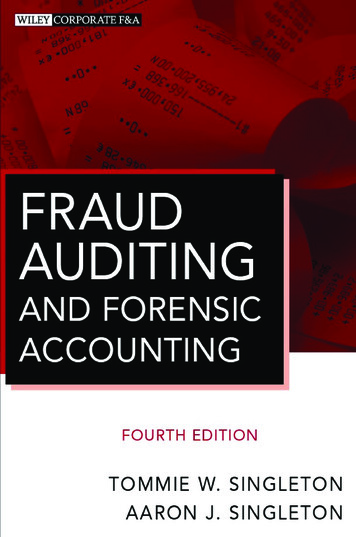
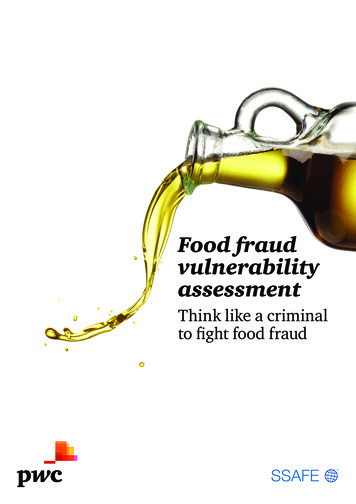
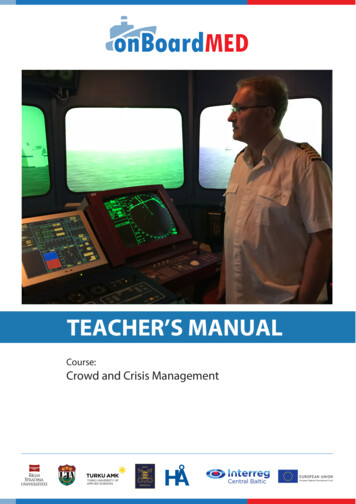
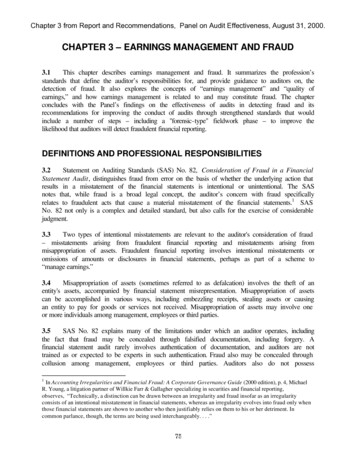



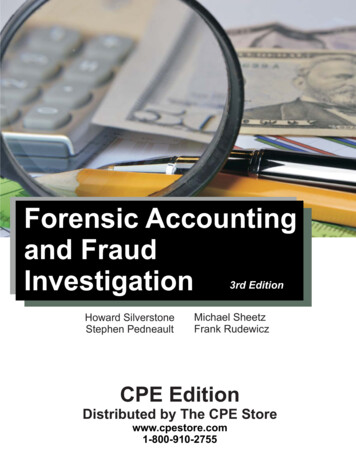
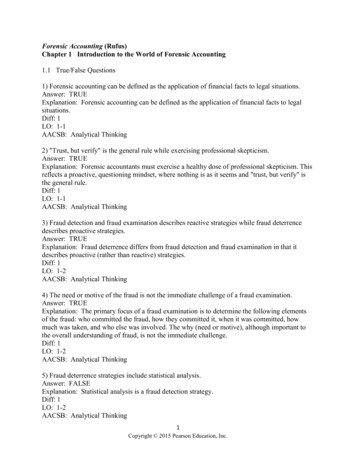

![[] 9 IA NCLUDING R THE R OF F](/img/1/modern-auditing-chapter09.jpg)